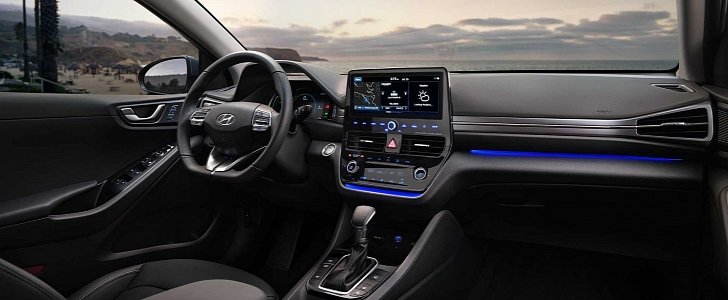Refreshed for the 2020 model year, the Ioniq was a tour de force a few years ago when Hyundai introduced it with three levels of electrification. To put it simply, no other automaker tried it before. Overhauled inside and out for the Los Angeles Auto Show, the Ioniq Electric is the pièce de résistance thanks to 170 miles of EPA-rated range.
The energy is stored in a 38.3-kWh battery, up from 28 kWh in the pre-facelift model. The Nissan Leaf with the 40-kWh battery can’t do better than 150 miles between charge-ups, and that stands as proof that Hyundai did well with this update.
Pricing information has yet to be announced, yet the 2019 model is still listed on the U.S. configurator at $29,815. The Ioniq Hybrid and Ioniq Plug-In start at $23,000 and $26,300 for the 2020 model year, representing increases of $600 and $950.
An electric motor drives the front wheels with 134 horsepower and 218 pound-feet of torque as opposed to 118 horsepower for the previous incarnation of the Ioniq Electric. The on-board charger is also better, now capable of 7.2 kW and fast-charging capability. A 100-kW station is capable of filling up the battery to 80 percent in 54 minutes.
In the case of the hybrid and plug-in hybrid, Hyundai retained the 1.6-liter engine and battery packs (1.56 and 8.9 kWh, respectively). The total system output is 139 horsepower and 195 pound-feet of torque for the hybrid while the plug-in hybrid levels up to 156 horsepower. Those who don’t need the all-electric range of the Ioniq Electric for their daily commute to work and back home should consider the plug in (29 miles). The Ioniq Plug-In should also appeal to those with range anxiety thanks to its Atkinson-cycle engine.
Changes are even more noticeable outside, but the interior of the 2020 Ioniq stands out for us. The upper and lower sections of the instrument panel have been redesigned, 8.0-inch touchscreen infotainment is standard across the range, and SmartSense technologies bundle driving assistants such as forward collision avoidance, automatic high beams, and driver attention warning.
Pricing information has yet to be announced, yet the 2019 model is still listed on the U.S. configurator at $29,815. The Ioniq Hybrid and Ioniq Plug-In start at $23,000 and $26,300 for the 2020 model year, representing increases of $600 and $950.
An electric motor drives the front wheels with 134 horsepower and 218 pound-feet of torque as opposed to 118 horsepower for the previous incarnation of the Ioniq Electric. The on-board charger is also better, now capable of 7.2 kW and fast-charging capability. A 100-kW station is capable of filling up the battery to 80 percent in 54 minutes.
In the case of the hybrid and plug-in hybrid, Hyundai retained the 1.6-liter engine and battery packs (1.56 and 8.9 kWh, respectively). The total system output is 139 horsepower and 195 pound-feet of torque for the hybrid while the plug-in hybrid levels up to 156 horsepower. Those who don’t need the all-electric range of the Ioniq Electric for their daily commute to work and back home should consider the plug in (29 miles). The Ioniq Plug-In should also appeal to those with range anxiety thanks to its Atkinson-cycle engine.
Changes are even more noticeable outside, but the interior of the 2020 Ioniq stands out for us. The upper and lower sections of the instrument panel have been redesigned, 8.0-inch touchscreen infotainment is standard across the range, and SmartSense technologies bundle driving assistants such as forward collision avoidance, automatic high beams, and driver attention warning.





































